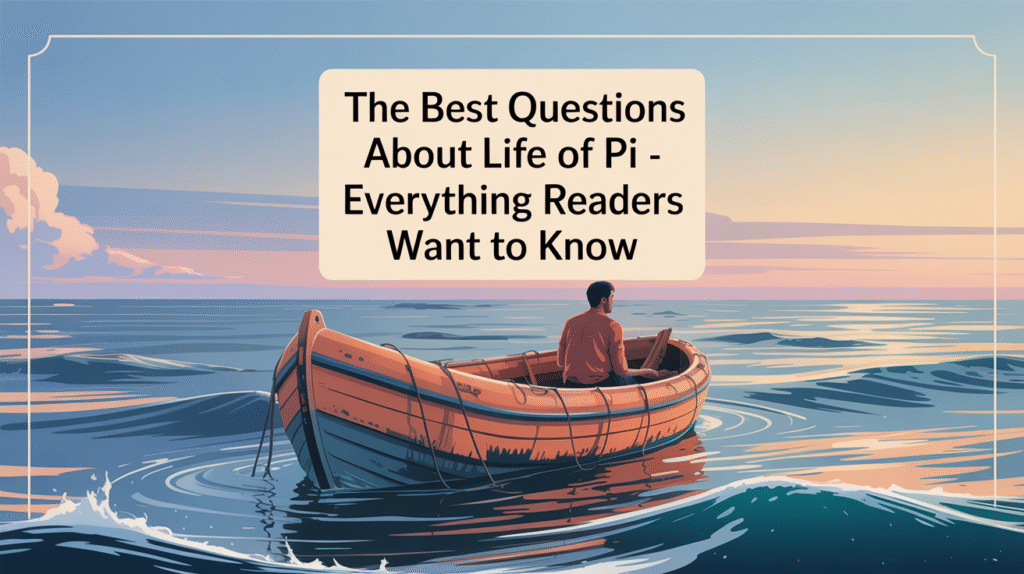The most frequently asked questions about Life of Pi center around its plot ambiguity, themes of faith, survival psychology, and the meaning behind its ending. Whether you’re a first-time reader or revisiting the book, these questions clarify some of the novel’s most talked-about mysteries.

Here are direct answers to the top reader questions about Yann Martel’s award-winning novel.
What Is the Main Message of Life of Pi?
The core message of Life of Pi is that belief—whether in God, survival, or storytelling—can be a powerful tool in facing adversity.
Choosing Belief Over Fact
- The novel invites readers to choose between two versions of a story, suggesting that belief in something beautiful can be more sustaining than harsh reality.
- It reflects the idea that life, like storytelling, is shaped by interpretation and perspective.
Spiritual Resilience
- Martel shows that faith, across different religions, can coexist and support a person through extreme hardship.
Which Story in Life of Pi Is True?
Pi offers two versions of his ordeal—one with animals and one with humans. The novel never confirms which is real, leaving it to the reader.
The Animal Story
- This version is symbolic and allegorical, with animals representing human traits and trauma responses.
- Many readers prefer this for its emotional and spiritual resonance.
The Human Story
- Told briefly at the end, this version is more graphic and realistic.
- It may reflect the harsh truth, but lacks the emotional and symbolic depth of the animal narrative.
Is Richard Parker Real or a Metaphor?
Richard Parker is both a real tiger in the story and a metaphor for Pi’s primal instincts.
Real within the Narrative
- Pi trains, fears, and coexists with the tiger, providing realistic survival details.
- The narrative treats Richard Parker as a physical presence.
Metaphorical Meaning
- Symbolically, Richard Parker represents Pi’s inner strength, survival instinct, and suppressed trauma.
- His disappearance without a farewell suggests he was never just a tiger.
What Does the Floating Island Symbolize?
The island symbolizes false security, illusion, and the dangers of losing one’s moral compass during isolation.
A Place of Temptation
- Pi finds food, fresh water, and rest—but discovers the island is carnivorous at night.
- It represents comfort that comes with hidden dangers, possibly a warning against complacency or spiritual emptiness.
A Test of Will
- Pi leaves the island once he understands its nature, signaling his refusal to give in to illusion or abandon hope of real rescue.
Why Does Pi Believe in Multiple Religions?
Pi practices Hinduism, Christianity, and Islam simultaneously to express his deep love for God in all forms.
Embracing All Paths
- Pi believes each religion offers unique insights into the divine.
- This challenges traditional religious exclusivity and highlights the novel’s theme of pluralism.
A Reflection of India
- Growing up in multi-religious India makes it natural for Pi to be exposed to and adopt diverse faiths.
What Is the Meaning of the Final Line?
The novel ends with a simple, emotionally loaded line from a Japanese official: “Very interesting…”
Reader Responsibility
- The ending asks the reader to choose which story to believe, making the book a mirror for personal worldview.
- It reinforces the theme that belief is a conscious choice—not always grounded in evidence, but sometimes in meaning.
Why Does Pi Cry When Richard Parker Leaves?
Pi feels abandoned when Richard Parker walks away without looking back, after everything they’ve been through.
A Deep Bond
- Despite being adversaries at first, they share the trauma of survival.
- Pi projected emotional companionship onto Richard Parker, and the silent departure is a painful emotional severance.
Loss of Identity
- Richard Parker represented Pi’s survival identity. His departure marks the end of that phase and the beginning of recovery.
FAQ: What Readers Want to Know About Life of Pi
Here are some questions and answers about the novel’s biggest mysteries and interpretations.
Is Life of Pi a true story?
No. It’s a fictional novel. However, it’s framed as a story that “will make you believe in God,” blending realism with allegory.
Why is the novel considered philosophical?
It explores existential questions, the nature of truth, the role of religion, and the psychology of survival, all wrapped in a symbolic narrative.
What genre does Life of Pi fall under?
It’s literary fiction with elements of adventure, allegory, magical realism, and philosophical fiction.
What age is appropriate to read Life of Pi?
It’s suitable for mature teens and adults. Some scenes of violence and trauma may not be appropriate for younger readers.
Does Life of Pi promote a specific religion?
No. It promotes faith and spirituality in a broader sense, showing respect for Hinduism, Christianity, and Islam equally.
Life of Pi continues to captivate and challenge readers worldwide because it dares to leave key answers unresolved. Its power lies in its openness—inviting you not just to follow a story, but to decide how you want to understand life itself.
